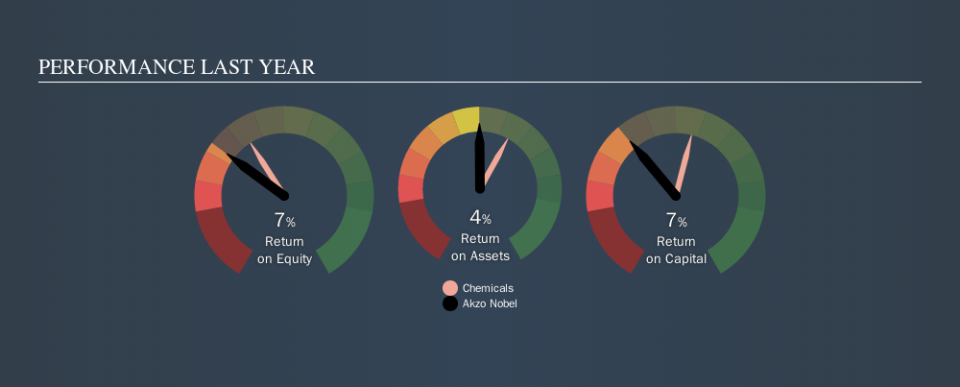Is Akzo Nobel N.V. (AMS:AKZA) Investing Effectively In Its Business?

Today we are going to look at Akzo Nobel N.V. (AMS:AKZA) to see whether it might be an attractive investment prospect. Specifically, we'll consider its Return On Capital Employed (ROCE), since that will give us an insight into how efficiently the business can generate profits from the capital it requires.
First, we'll go over how we calculate ROCE. Then we'll compare its ROCE to similar companies. And finally, we'll look at how its current liabilities are impacting its ROCE.
Return On Capital Employed (ROCE): What is it?
ROCE is a measure of a company's yearly pre-tax profit (its return), relative to the capital employed in the business. Generally speaking a higher ROCE is better. Ultimately, it is a useful but imperfect metric. Author Edwin Whiting says to be careful when comparing the ROCE of different businesses, since 'No two businesses are exactly alike.
So, How Do We Calculate ROCE?
The formula for calculating the return on capital employed is:
Return on Capital Employed = Earnings Before Interest and Tax (EBIT) ÷ (Total Assets - Current Liabilities)
Or for Akzo Nobel:
0.072 = €754m ÷ (€14b - €3.6b) (Based on the trailing twelve months to September 2019.)
Therefore, Akzo Nobel has an ROCE of 7.2%.
View our latest analysis for Akzo Nobel
Does Akzo Nobel Have A Good ROCE?
One way to assess ROCE is to compare similar companies. Using our data, Akzo Nobel's ROCE appears to be around the 8.6% average of the Chemicals industry. Setting aside the industry comparison for now, Akzo Nobel's ROCE is mediocre in absolute terms, considering the risk of investing in stocks versus the safety of a bank account. It is possible that there are more rewarding investments out there.
Akzo Nobel's current ROCE of 7.2% is lower than its ROCE in the past, which was 14%, 3 years ago. Therefore we wonder if the company is facing new headwinds. The image below shows how Akzo Nobel's ROCE compares to its industry, and you can click it to see more detail on its past growth.
When considering ROCE, bear in mind that it reflects the past and does not necessarily predict the future. ROCE can be deceptive for cyclical businesses, as returns can look incredible in boom times, and terribly low in downturns. ROCE is only a point-in-time measure. Future performance is what matters, and you can see analyst predictions in our free report on analyst forecasts for the company.
Akzo Nobel's Current Liabilities And Their Impact On Its ROCE
Liabilities, such as supplier bills and bank overdrafts, are referred to as current liabilities if they need to be paid within 12 months. The ROCE equation subtracts current liabilities from capital employed, so a company with a lot of current liabilities appears to have less capital employed, and a higher ROCE than otherwise. To counter this, investors can check if a company has high current liabilities relative to total assets.
Akzo Nobel has total liabilities of €3.6b and total assets of €14b. As a result, its current liabilities are equal to approximately 26% of its total assets. It is good to see a restrained amount of current liabilities, as this limits the effect on ROCE.
Our Take On Akzo Nobel's ROCE
With that in mind, we're not overly impressed with Akzo Nobel's ROCE, so it may not be the most appealing prospect. Of course, you might find a fantastic investment by looking at a few good candidates. So take a peek at this free list of companies with modest (or no) debt, trading on a P/E below 20.
Akzo Nobel is not the only stock insiders are buying. So take a peek at this free list of growing companies with insider buying.
We aim to bring you long-term focused research analysis driven by fundamental data. Note that our analysis may not factor in the latest price-sensitive company announcements or qualitative material.
If you spot an error that warrants correction, please contact the editor at editorial-team@simplywallst.com. This article by Simply Wall St is general in nature. It does not constitute a recommendation to buy or sell any stock, and does not take account of your objectives, or your financial situation. Simply Wall St has no position in the stocks mentioned. Thank you for reading.

 Yahoo Finance
Yahoo Finance 
